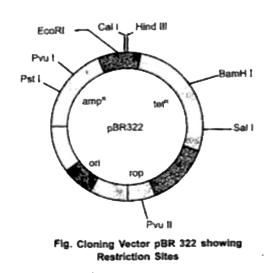Define recombinant DNA technology. Describe the various tools required for rDNA technology.
Text Solution
Key tools used in recombinant DNA technology.
1. Cloning vector 2. Competent host 3. Restriction enzymes 4. DNA Ligase 5. Alkaline Phosphatase 6. DNA polymerase enzymes

1. Cloning Vectors (1) Plasmids and bacteriophages are the commonly used vectors.
(2) Presently genetically engineered/synthetic vectors are also used for easily linking the foreign DMA and selection of recombinants from non-recombinants.
(3) The following features are required to facilitate cloning in a vector (i) Origin of replication (Ori) (ii) Selectable marker (iii) Cloning (Recognition) site (iv) Small size of vector.
(4) The Ti plasmid (Tumour-inducing Plasmid) of Agrobacterium tumefaciens has been modified (does not cause tumour) and used as a cloning vector. (5) The retroviruses have also been modified/disarmed and used as vectors for transferring DNA into animal cells.
2. Competent host (For transformation with recombinant DNA) -
(1) For transformation bacterial cells are treated with a specific concentration of calcium which increases the efficiency with which DNA enters the bacterium through pores in its cell wall. (2) Cells with recombinant DNA are incubated on ice, followed by placing them briefly at 42∘C (heat shock) and then putting them back into ice. This enables the bacteria to take up recombinant DNA.
|
Topper's Solved these Questions
- PRINCIPLES AND PROCESSES IN BIOTECHNOLOGY BOOK - BETTER CHOICE PUBLICATIONCHAPTER - PRINCIPLES AND PROCESSES IN BIOTECHNOLOGY EXERCISE - SHORT ANSWER TYPE QUESTIONS (MOST EXPECTED QUESTIONS )
8 Videos
- ORGANISMS AND POPULATIONSBOOK - BETTER CHOICE PUBLICATIONCHAPTER - ORGANISMS AND POPULATIONSEXERCISE - LONG ANSWER TYPE QUESTIONS (MOST EXPECTED QUESTIONS)
7 Videos
- PRINCIPLES OF INHERITANCE AND VARIATION BOOK - BETTER CHOICE PUBLICATIONCHAPTER - PRINCIPLES OF INHERITANCE AND VARIATION EXERCISE - LONG ANSWER TYPE QUESTIONS
31 Videos
Similar Questions
Knowledge Check
Recombinant DNA technology is also called
ABiotechnologyBModern biotechnologyCGenetic engineeringDTransgenic technologyWhich is used in recombinant DNA technology ?
AVirusBCapsid of virusCCell wall of virusDGene which produces capsid of virusAssertion Vector is very useful in recombinant DNA technology.
Reason Vector is a tool that carries a foreign DNA molecule to the living cell.ABoth Assertion and Reason are true and the Reason is correct explanation of the AssertionBBoth Assertion and Reason are true but the Reason is not the correct explanation of the AssertionCAssertion is true, but the Reason is falseDAssertion is false, but the Reason is true
Identify the tools of r-DNA technology
View SolutionList the key tools used in recombinant DNA technology
View SolutionList the key tools used in recombinant DNA technology
View SolutionList the key tools used in recombinant DNA technology
View SolutionName the five key tools for accomplishing the tasks of recombinant DNA technology. Also mention the functions of each tool.
View Solution
